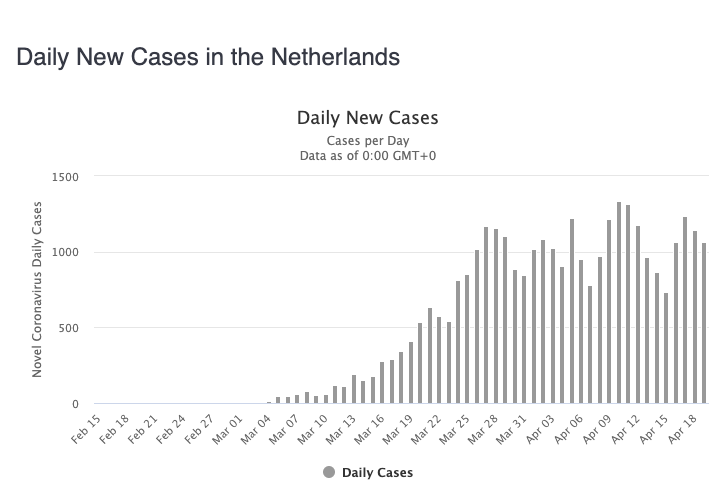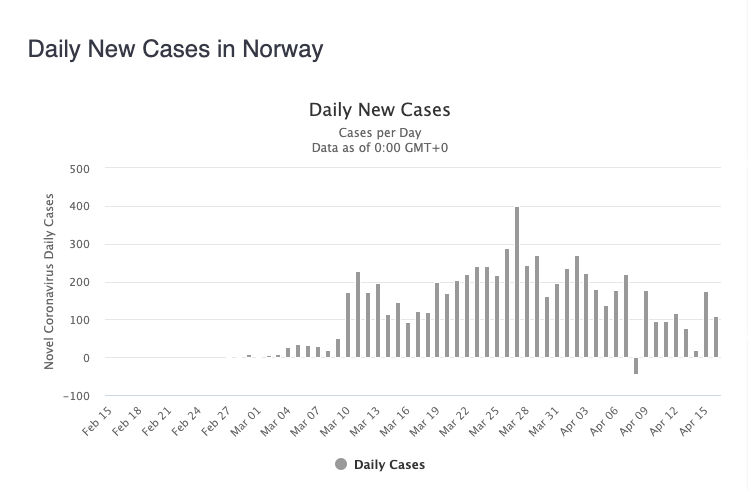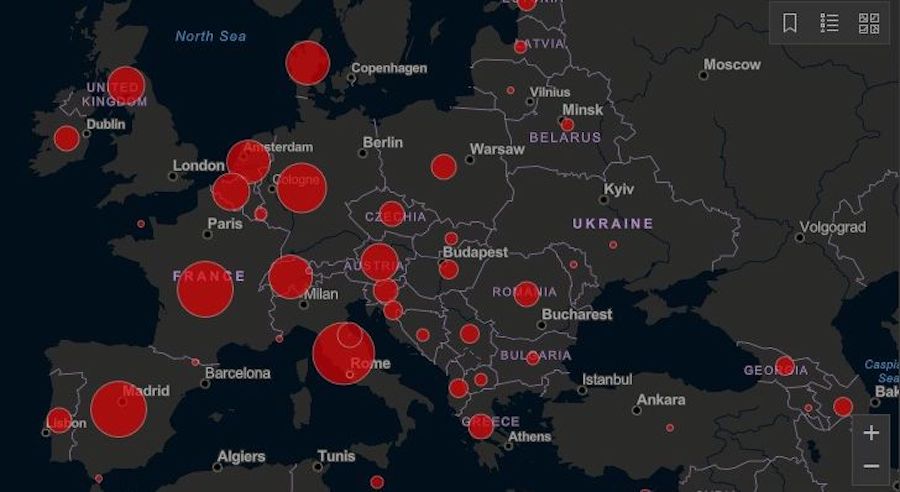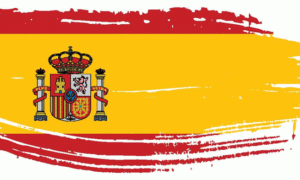
Netherlands
The Dutch have a strategy for everything from controlling the North Sea to restoring former forests into natural heaths. The plan for the coronavirus pandemic? Double down on the herd immunity approach, control the infection rate and hope those infected now will be sufficient to stop new outbreaks later. Of course, no one will know for months or even years whether this works. However, at least one public health institute projects that about 3 percent of the population, or 500,000 people, have the coronavirus antibody.
So Dutch officials are going through with lifting coronavirus restrictions starting 28 April.
Schools and childcare facilities would open first. After that it is “conceivable” restaurants, cinemas and gyms might reopen gradually, RTL quotes officials as saying. This comes after the Netherlands recorded the lowest number of deaths in 24 hours – 83 on 19 April – since 23 March. The Netherlands set a mortality record on 7 April with a spike of 234 deaths in 24 hours, up almost 40 percent from the previous record on 5 April. But the number of new daily cases has basically plateaued during April with an average of almost 1,200 new cases every 24 hours.
So there’s not true flattening as in countries such as Italy and Germany. In fact, Germany basically declared the Netherlands a hot zone, stopping Dutch people at the border who don’t have “urgent business” in Germany. On 10 April, Germany started requiring its returning citizens to self-quarantine at home for 14-days.
On 31 March, Prime Minister Mark Rutte announced an extension of coronavirus measures, with cafés, restaurants and other public gathering places remaining closed until at least 28 April, with school not reopening until 3 May. That was after said on 16 March that the Netherlands “can delay the spread of the virus and at the same time build up population immunity in a controlled manner.”
Still, the whole social-distancing thing never caught on here, and police are breaking up parties – complete with DJs and light shows – all over the country. Also, a lot of the measures are merely suggested and not policed.
Netherlands now has almost 30,500 reported COVID-19 cases.
Earlier this month, Dutch government in Den Haag finally started restricting citizens with a list of new rules including:
• no gatherings until 1 June
• no group walks, which is a thing here
• no more than three visitors in private homes. No more big neighborhood parties
• salons and barbers are closed until the end of April
But as other countries have closed aiports, the Netherlands is still allowing limited flights in and out and a surprising number of stores and businesses are still open.
The death rate is 202 deaths per million in population, the sixth-highest in the world behind the UK, France, Belgium, Italy and Spain.
To respond, at least two hotel chains – The Van der Valk and Fletcher – announced they’re converting some of their hotels into hospitals. Conventional hospitals are switching to war footing, with Philips and other tech companies switching to producing more respirators.
Despite all this, life here didn’t change. dramatically.
King Willem-Alexander addressed the nation on 20 March, praising the people who keep Dutch society up and functioning: doctors and healthcare workers, logistics workers, supermarkets stockers, cleaners, IT workers, childcare workers, transport workers and the police.
The king’s speech came after the minister leading the Netherlands’ efforts to control the virus passed out from exhaustion during a parliamentary debate, then promptly quit, according to Reuters.
Hospitals around the Netherlands, including the hotspot of North Brabant province, set up triage tents outside on the grounds to test suspected coronavirus cases before patients enter new, dedicated COVID-19 treatment areas. But as of 5 April, the number of coronavirus admissions is dropping.
The first case was reported 27 February in Tilburg in the south of the Netherlands, and the majority of Dutch cases have been reported in the North Brabant province. Rutte himself asked people in the North Brabant province specifically to work from home if they could until 1 April, and the Netherlands has closed its borders to non-EU travelers. Of course, the pot cafés have reopened.
The Dutch House of Representatives ordered universities to switch to online courses for the remainder of the year, and all the major museums are closed.
The Dutch have one of the top-rated healthcare systems in the world, if not the best, so this promises to be a major test of capacity. There’s a government coronavirus website that’s constantly updated with the latest information. Or if you’re in the Netherlands, you can call 0800-1351 from 8 a.m. till 8 p.m.
– Terry Boyd in Eindhoven
Number of reported cases: 33,405, up an aggregate 3,369 percent from 960 on 14 March (this includes Dutch overseas territories)
Number of deaths: 3,751, up an aggregate 31,158 percent from 12 on 14 March
Number of patients recovered: 250

Norway
As of 17 April, Norway’s logarithmic charts shows classic flatlining and officials announced pre-schools are open as of Monday, 20 April. So it will be one of the first countries in Europe to return to “normal.” Though of course next door, Sweden never shut down.
Also, Norwegian officials they’ll start relaxing border restrictions starting with allowing more EEA citizens to return to their jobs in Norway.
Norway had tested more than 103,000 of its 5.4 million people as of 5 April, a far higher percentage than every country in the world except the United Arab Emirates and Iceland.
The rate of new cases in 24 hours has dropped to 20 on 14 April from a high of 400 on 27 March, a decline of 181 percent.
On Thursday, 19 March Norway announced it’s taking “the strongest ever peacetime measures” to contain coronavirus. In a nutshell, everything is closing, and the Norwegians forbade healthcare workers from leaving the country, according to Reuters.
Both the king and queen were in quarantine and anyone entering the country will be quarantined for 14 days. Anyone violating quarantine faces a 20,000 krone fine, or about $2,000.
Of course, oil-rich Norway has a cushion few other countries have … a trillion euro sovereign wealth fund that can cover all the lost wages of parents staying home to care for kids. Though that fund is taking serious hits as equity markets struggle and officials are withdrawing cash to make up for plunging petroleum prices, which recently fell to under $20 per barrel from more than $165 dollars back in 2008.
Number of reported cases: 7,156, up an aggregate of 545 percent from 1,109 as of 14 March
Number of deaths: 181, with a deaths per million in population rate that’s risen to 33 from 4.89 since 11 April. On 20 April, Norway reported its highest number of deaths in 24 hour periods at 16.
Number of recovered patients: 32, up from 7 on 30 March
Portugal
(Editor’s note: See Liina Edun’s detailed dispatch from Portugal here.)
The pandemic hit Portugal later than in the rest of Europe and it was one of the last EU countries to declare a state of emergency, this one for 15 days. But when it hit, it hit hard. On 31 March, confirmed coronavirus cases in a 24-hour period rose to a record 1,035, a 13-percent increase over the previous peak of 902 on 28 March.
Then on 10 April, Portugal reported its highest number of cases in a 24-hour period so far at 1,516 and deaths spiked at 35, just two less than at the peak of the pandemic on 3 April.
Yet, Portugal’s overall trend lines are so favorable Der Spiegel has a post (in English) about the “Portuguese Miracle” and why the country has fared so much better than neighboring Spain.
So far, the deaths per million in population rate is 72, still relatively low.
Government measures in the pandemic include restricting freedom of movement, temporary requisitioning businesses, suspension of the right to strike and restrictions to protests and public gatherings, according to the New York Times. The military could be deployed to enforce the measures.
But, there is no general lock-down and Portuguese authorities are already laying out beach rules for the summer.
From Liina’s new post:
Even now, 1 April, there is no official lock down in Portugal requiring people to have permission to go for essentials such as grocery shopping. Unlike in Italy, residents are still allowed to be outside provided they maintain social distancing and that they only go out when absolutely necessary. People are able to go out to walk their dogs or go for a run provided it’s in their neighbourhood.
Portugal also announced 28 March that all people with pending citizenship applications will be treated as citizens, with access to healthcare, welfare benefits and housing, according to Reuters.
Unlike neighboring Spain, coronavirus had been mostly contained in Portugal, with the country reporting its first death on 16 March. While Portugal has avoided the stratospheric infection rates of neighboring Spain, Portugal is one of the older countries in Europe in demographic terms, with 21 percent of the population over age 65.
Total reported cases: 20,863, up an aggregate 6,203 percent from 331 on 17 March
Total deaths: 735, up about 36,650 percent from 2 on 18 March
Total patients recovered: 610, up from 5 on 23 March














